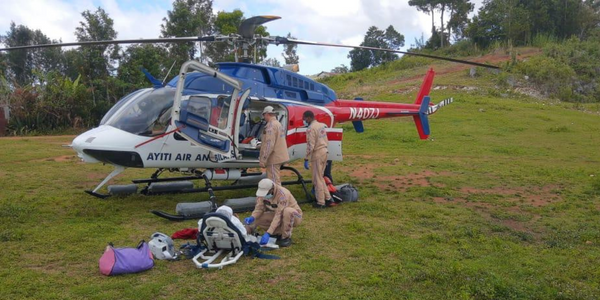Imagine this scenario: you or a loved one suddenly starts experiencing the symptoms of a stroke. Time is of the essence, every second counts. But what if you live in a remote area far away from the nearest hospital? This is where air ambulances come into play. In this article, we will explore the concept of the “Golden Hour” when it comes to stroke patients and how air ambulances can make all the difference in ensuring timely and life-saving treatment. So sit back, relax, and let’s dive into this important topic together.

Introduction
Hey there! If you or someone you know has experienced a stroke, then you’re likely aware of the critical importance of timely medical intervention. When it comes to strokes, every second counts, and a concept known as the “Golden Hour” has become crucial in enhancing the chances of a successful recovery. In this article, we’ll explore the concept of the “Golden Hour” and delve into how air ambulances play a significant role in providing timely and specialized care for stroke patients.
What is the ‘Golden Hour’ concept?
The “Golden Hour” is a term used in the medical field to describe the critical first 60 minutes following a medical emergency, such as a stroke. During this window of time, rapid intervention can significantly improve a patient’s outcomes and increase the chances of a full recovery. Every minute wasted can lead to irreversible damage to the brain, making it imperative to minimize the time it takes for medical professionals to begin treatment.

Understanding Stroke
Before we dive into the role of air ambulances in stroke cases, it’s essential to have a basic understanding of what a stroke is and its various types. A stroke occurs when the blood supply to the brain is interrupted, resulting in the death of brain cells. This interruption can happen due to either a blockage in the blood vessels (ischemic stroke) or bleeding in the brain (hemorrhagic stroke).
Types of Stroke
Ischemic strokes account for the majority of stroke cases, where a blood clot forms and obstructs blood flow to the brain. On the other hand, hemorrhagic strokes occur when a weakened blood vessel ruptures, causing bleeding within the brain.
Signs and Symptoms
Recognizing the signs and symptoms of a stroke is crucial for seeking immediate medical attention. Common symptoms include sudden weakness or numbness in the face, arm, or leg, particularly on one side of the body. Other signs may include difficulty speaking, severe headaches, dizziness, and loss of coordination. If you or someone you know experiences any of these symptoms, don’t hesitate to call emergency services right away.
Importance of Timely Treatment
Timely treatment for stroke is essential to minimize the damage caused to the brain. The sooner medical intervention is provided, the better the chances of reducing disabilities and improving the overall prognosis. This is where air ambulances come into play, providing rapid transportation to specialized stroke centers that can deliver the necessary care.
Air Ambulances and Stroke Patients
Air ambulances are specially equipped aircraft that serve as a means of transporting patients who require urgent medical care. They are particularly well-suited for stroke patients as they offer the ability to rapidly transport individuals to stroke centers, even in remote locations where ground transportation may be impractical or time-consuming.

Benefits of Air Ambulances for Stroke Patients
Air ambulances offer several benefits when it comes to transporting stroke patients. Let’s explore a few of them:
Reduced Transport Time
By utilizing air ambulances, the time taken to transport stroke patients to specialized stroke centers is significantly reduced. This is crucial since every minute counts during the “Golden Hour.” Air ambulances can swiftly navigate through traffic congestion and bypass geographical barriers, enabling patients to receive timely treatment.
Access to Specialized Care
Stroke centers are specifically equipped to provide the specialized care that stroke patients require. By utilizing air ambulances, patients can be rapidly transported to these facilities, increasing their access to medical professionals who specialize in stroke treatment. This ensures that patients receive the best possible care, increasing their chances of a positive outcome.
Ability to Monitor and Treat during Transport
One of the significant advantages of air ambulances is the ability to provide medical care and monitoring during transportation. Stroke patients require continuous monitoring to assess their condition and ensure that any changes are quickly addressed. Air ambulances are staffed with medical professionals who can administer care while in transit, providing an added layer of safety and comfort to the patient.
Air Ambulance Staff and Training
Air ambulance services employ highly trained medical professionals who specialize in providing critical care during transport. These dedicated individuals play a vital role in ensuring the well-being of stroke patients throughout the journey.
Medical Team
The medical team typically consists of doctors, nurses, and paramedics who have undergone extensive training in critical care medicine. They are skilled in managing emergencies and are equipped to handle any complications that may arise during transport.
Skills and Training
Air ambulance medical professionals undergo specialized training to develop the skills necessary to care for patients in a high-stakes environment. They are trained in advanced life support techniques, patient monitoring, and emergency procedures, ensuring that they can provide the best possible care throughout the transfer.
Equipment and Facilities
Air ambulances are equipped with state-of-the-art medical equipment and facilities to ensure the well-being of the patient during transport. Essential equipment such as cardiac monitors, ventilators, and medication for emergencies are readily available on board. These resources allow the medical team to provide immediate medical intervention when needed.
Considerations for Air Ambulance Transfers
While air ambulances provide a valuable service for stroke patients, there are several considerations that need to be taken into account before arranging a transfer.
Patient Selection
Not all stroke patients may be suitable for air ambulance transfers. Factors such as the stability of the patient’s condition, the severity of the stroke, and the distance to the receiving stroke center all play a role in determining the appropriateness of an air ambulance transfer.
Weather Conditions
Weather conditions can significantly impact the feasibility of air ambulance transfers. Inclement weather, such as heavy rain, fog, or high winds, may pose safety risks and prevent the aircraft from taking off or landing. In such cases, ground transportation may be the only viable option.
Cost and Insurance
Air ambulance transfers can be costly, and the availability of insurance coverage may vary. It’s important to consider the financial aspects and discuss them with relevant stakeholders, including insurance providers, to ensure that the necessary arrangements are made.
How to Arrange for an Air Ambulance Transfer
Arrange an air ambulance transfer requires coordination with medical transport services. Let’s take a step-by-step look at how to make this happen:
Contacting a Medical Transport Service
First and foremost, reach out to a reputable medical transport service that offers air ambulance services. Research different providers and choose one that has a strong track record in transporting stroke patients efficiently and safely.
Providing Necessary Information
When contacting the medical transport service, it’s essential to provide accurate and detailed information about the patient’s condition. This information helps the medical transport team assess the situation and determine the appropriateness of an air ambulance transfer.
Coordinating with Healthcare Providers
To ensure a smooth transfer process, it’s crucial to coordinate with the patient’s healthcare providers. This includes obtaining medical records, sharing relevant information, and working in collaboration with the medical team to ensure a seamless transition of care.

Preparation for Air Ambulance Transfer
Preparing for an air ambulance transfer involves several important steps to ensure the safety and well-being of the patient throughout the journey.
Preparing the Patient
The medical team will provide guidance on preparing the patient for the transfer. This may include instructions on medications, fasting requirements, and any necessary medical interventions before and during the transfer.
Transporting Medical Records
Accurate and up-to-date medical records are essential during an air ambulance transfer. These records provide valuable information about the patient’s medical history, current condition, and any relevant treatment plans. Ensure that all necessary medical records are available and easily accessible for the medical team.
Travel Accompaniment
Depending on the patient’s condition, it may be necessary to have a family member or caregiver accompany them during the air ambulance transfer. This can provide emotional support and assist with any immediate needs the patient may have during the journey.
Conclusion
In summary, the “Golden Hour” concept emphasizes the critical need for timely medical intervention following a stroke. Air ambulances play a vital role in reducing transport time, providing access to specialized care, and ensuring continuous monitoring and treatment en route to stroke centers. The skilled medical professionals and state-of-the-art equipment on board air ambulances ensure that stroke patients receive the necessary care, even while in transit. Understanding the role of air ambulances and the steps involved in arranging a transfer can help ensure that stroke patients receive the best possible care during this crucial timeframe.



